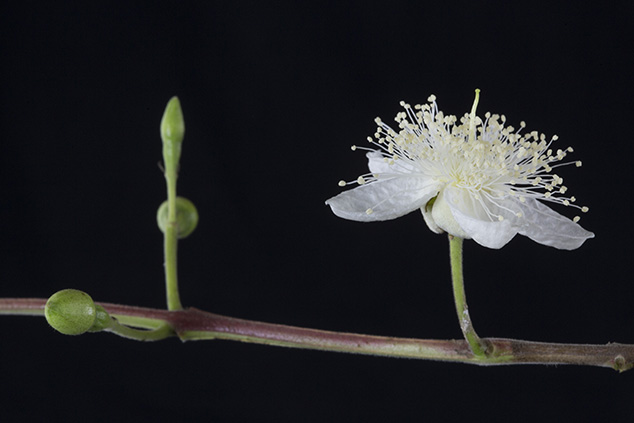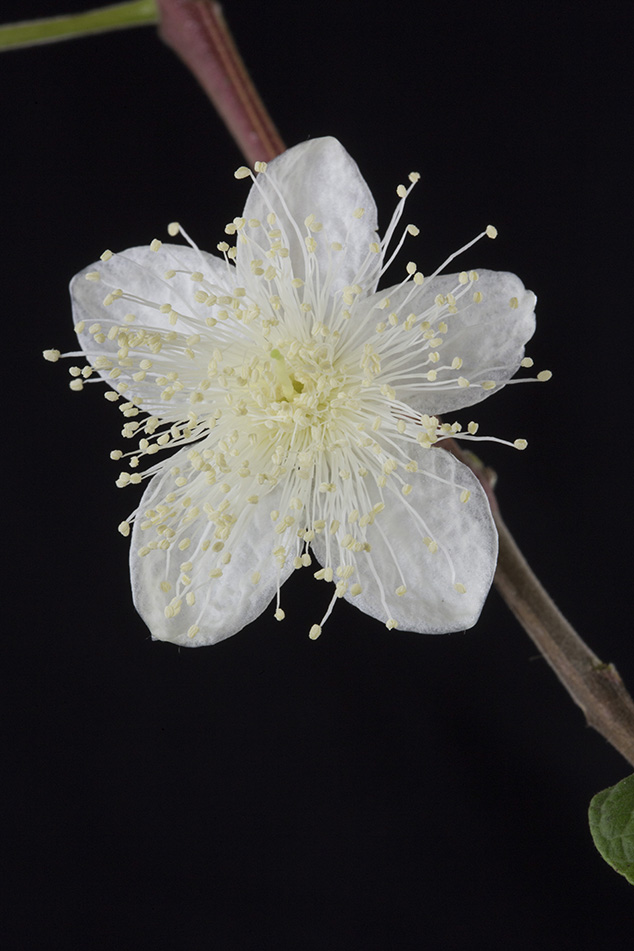Guava, Guayaba, Psidium guajava L
Guava is the English word for what is called guayaba in Mesoamerica. The botanical name is Psidium guajava L. Family Myrtaceae. In Guatemala it grows both in the Highlands (in the FLAAR garden at 1500 meters as an example) and in the Lowlands (in a hotel in Teleman, though that is higher altitude than El Peten).
The flower is a beautiful white color. The tree blooms in our garden during April. In Teleman, Alta Verapaz the tree was blooming in February. The trunk is very smooth.
What is impressive about this tree is the extensive range of uses, yet as a North American, I had never really heard much about the tree other than occasional mention as edible. As a Mayanist I never saw this tree featured in any monograph on Maya diet. Now that I have studied the literature it is pretty amazing that a tree with as many useful features has been so forgotten, literally ignored in studies of the Maya culture. Every article speaks about its aroma and flavor, so clearly this fruit is worthy of more study.
No wonder the ancient Maya did so well without modern chemicals and without modern conveniences. If every family had a few multi-use fruit and medicinal trees in the yard around their house they could survive relatively well.
Mayan words for Guava, Psidium guajava
Thompson sais that in one part of Belize it is called pitsi or putah (1930:190).
Guava is a medicinal plant
The leaves are a key source of medicinal chemicals. But it turns out that practically every part of the plant, including the roots, can be used. Indeed the lists of diseases and conditions treated in folk medicine by parts of the guava plant is mind-boggling. A comprehensive list of treatments from this tree is summarized in Shruthi, Roshan, Timilsina and Sunita 2013, page 162.
It contains important phytoconstituents such as tannins, triterpenes, flavonoid: quercetin, pentacyclic triterpenoid: guajanoic acid, saponins, carotenoids, lectins, leucocyanidin, ellagic acid, amritoside, beta-sitosterol, uvaol, oleanolic acid and ursolic acid. In view of the immense medicinal importance of the plant, this review is an effort to compile all the information reported on its ethanobotanical, phytochemical and pharmacological activities. The present work attempts to generate interest among the masses regarding its potential in preventing and treating several common diseases. Many pharmacological studies have demonstrated the ability of this plant to exhibit antioxidant, hepatoprotective, anti-allergy, antimicrobial, antigenotoxic, antiplasmodial, cytotoxic, antispasmodic, cardioactive, anticough, antidiabetic, antiinflamatory and antinociceptive activities, supporting its traditional uses. Suggesting a wide range of clinical applications for the treatment of infantile rotaviral enteritis, diarrhoea and diabetes (Shruthi, Roshan, Timilsina and Sunita 2013:162).
Considering that the total list of medicinal plants of Mesoamerica is in the hundreds, any Shaman or curer who had several dozen different species with as much diversity as guava would have a veritable pharmacy in their front yard.
If you are studying Mayan herbal medicine, plant remedies, traditional healing plants, be sure to look at guava. It looks great for your health.
Psidium guajava L. Guava Flower, photo by Sofia Monzon.
Guava is an edible fruit
Because of its distinctive “aroma” and thus a rather curious taste, some people just love guava, and others will not eat it. But it is reportedly very very healthy (hopefully even as jelly, since sugar is not very healthy).
Guava leaves can be smoked
Thompson says that the leaves are used by the Maya of the Highlands to wrap their cigarettes 1930:190-191). Thompson is not more specific.
Guava produces tannins and dye
We are still researching this aspect, but guava is listed as producing tannin and dye colorant.
Growing guava as a garden plant
We planted a guava, probably as a cutting, perhaps four years ago. It never attracted any attention and I was close to moving it to make way of something more visual exciting, but for one reason or another I never got around to having the tree removed. Then in April 2014 the tree bloomed while I was giving a lecture in Dubai. When I returned Sofia Monzon took some lovely photos in the FLAAR studio.
Guava Flower, photo by Sofia Monzon.
- 2013
- A Review on the Medicinal Plant Psidium guajava (Myrtaceae). Journal of Drug Delivery & Therapeutics; 2013, 3(2), 162-168.
First posted April 23, 2014.















































































